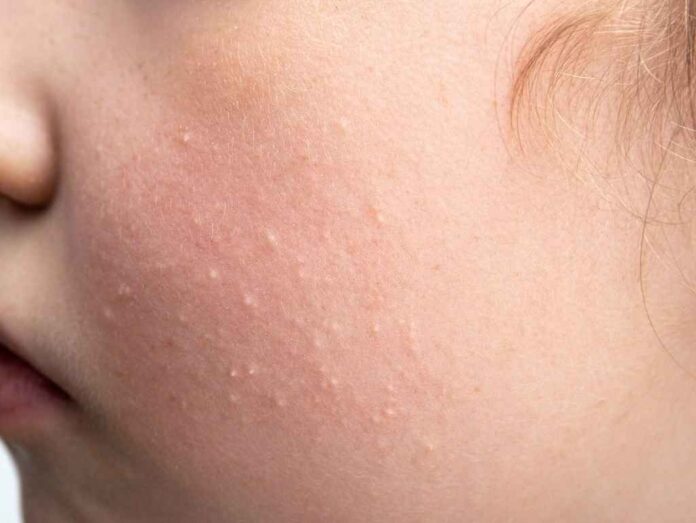Are you tired of waking up every morning to tiny, stubborn white bumps on your face that won’t go away? You may be suffering from Milialar. Whether as a skincare serum or a skin condition, milia can be an annoying and frustrating experience for anyone.
In this ultimate guide to Milialar, we will explore everything you need to know about this common skin condition. From its origin and causes to identifying symptoms and treatment strategies – this guide has covered you. We will also touch upon the role of medical professionals in diagnosis and how you can adapt to life with milia.
Introduction to Milialar
Milialar is also known as Milium Cysts. These are tiny, raised white or yellowish bumps that can appear on the skin, most commonly on the nose and cheeks. While they may resemble acne or pimples, milia are different and require a unique approach to treatment. Milialar can affect anyone, regardless of age. Bumps on the skin are caused by keratin, a protein that gets stuck under the skin.
Identifying milialar and differentiating between its various types is crucial in determining the appropriate treatment. Seeking professional advice and exploring treatment options tailored to your unique skin can help you achieve a clear complexion. Remember to consult dermatologists or skincare specialists for valuable insights into dealing with milialar.
The Origin of Milialar
The formation of milia, tiny cysts, on the skin’s surface causes Milialar. It occurs due to the skin’s natural process of shedding dead skin cells and excess oil production. Additionally, secondary milia can develop as a result of skin damage, inflammation, or the use of steroid creams. Factors such as facial expressions, sun exposure, and skin type contribute to Milialar. Understanding these causes is crucial for effective treatment and prevention strategies. By addressing the origin of Milialar, individuals can take steps towards achieving a clear complexion and maintaining a unique skincare routine.
What are the Symptoms of Milialar?
Milialar is a small white or yellow bump on the skin, commonly seen on the nose and cheeks. Unlike pimples, it doesn’t cause redness or pain. It might cause mild itching or irritation, though. Anyone can get milia, regardless of age or skin type. Furthermore, milialar can occur in clusters or individually, and their size may vary. These tiny cysts are often firm and can be easily mistaken for acne or pimples. However, it is essential to note that milia are different from these common skin issues and require a unique approach to treatment.
Identifying milialar and differentiating between its various types is essential in determining the appropriate treatment. Seeking professional advice from dermatologists or skincare specialists is highly recommended to ensure accurate diagnosis and tailored treatment options for your specific case.
Treatment Strategies for Milia
The treatment of Milialar involves various strategies aimed at effectively removing the cysts and preventing their recurrence. Below are some common treatment strategies for milialar:
- Manual Extraction:
If you want to eliminate milia, you can extract them manually. A professional like a dermatologist or esthetician will use a sterile needle or blade and take the milia out carefully. It’s essential to have an expert do it so that you won’t have scars or infections.
- Chemical Peels:
The blog discusses how chemical peels can help improve skin texture and prevent new milia formation. Chemical peels contain alpha hydroxy or salicylic acids that remove dead cells, including milia. With regular use, chemical peels promote the shedding of dead cells, improving overall skin texture.
- Cryotherapy:
In some cases, cryotherapy may be recommended to freeze off the milia using liquid nitrogen. This technique is often used for more extensive or stubborn cysts and should only be performed by a trained professional to avoid damage to surrounding tissues.
- Microdermabrasion:
This procedure involves removing the top layer of dead skin cells using a handheld device that emits tiny crystals. Microdermabrasion can help improve the appearance of milia by gently exfoliating the skin and promoting cell turnover. Multiple sessions may be required for optimal results.
- Laser therapy:
Laser treatment is another option for removing milia. This method uses focused laser energy to target and destroy the cysts, promoting their gradual disappearance. Qualified doctors and dermatologists can recommend laser therapy to treat milia effectively.
If you have milia, some treatments can remove them. But new ones might still grow later. Consult a skincare expert for assistance. They will give you personalized advice and suggest a good skincare routine. In this way, you can reduce your risk of getting more milia.
Conclusion
In conclusion, diagnosing Milialar is crucial for effective treatment and management. It’s essential to recognize Milialar as a skincare serum and a skin condition, with different approaches required for each. Seeking professional medical advice and undergoing the necessary diagnostic procedures is essential for accurate diagnosis. While there may not be a cure for Milialar, there are various treatment options available to manage its symptoms and improve the condition of the skin.

